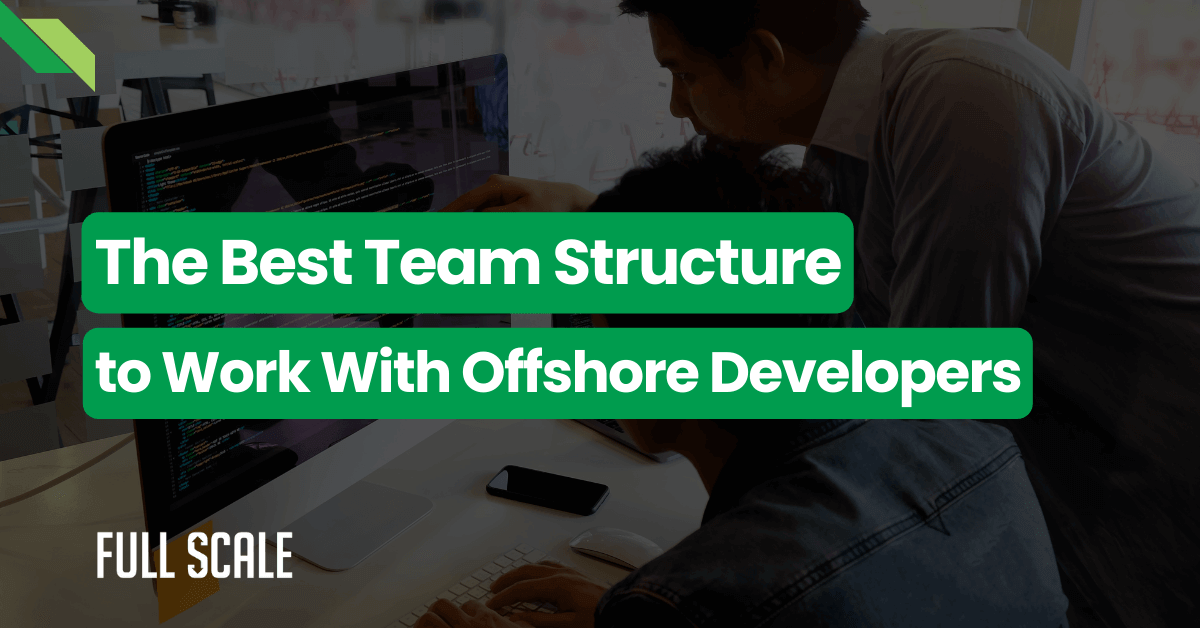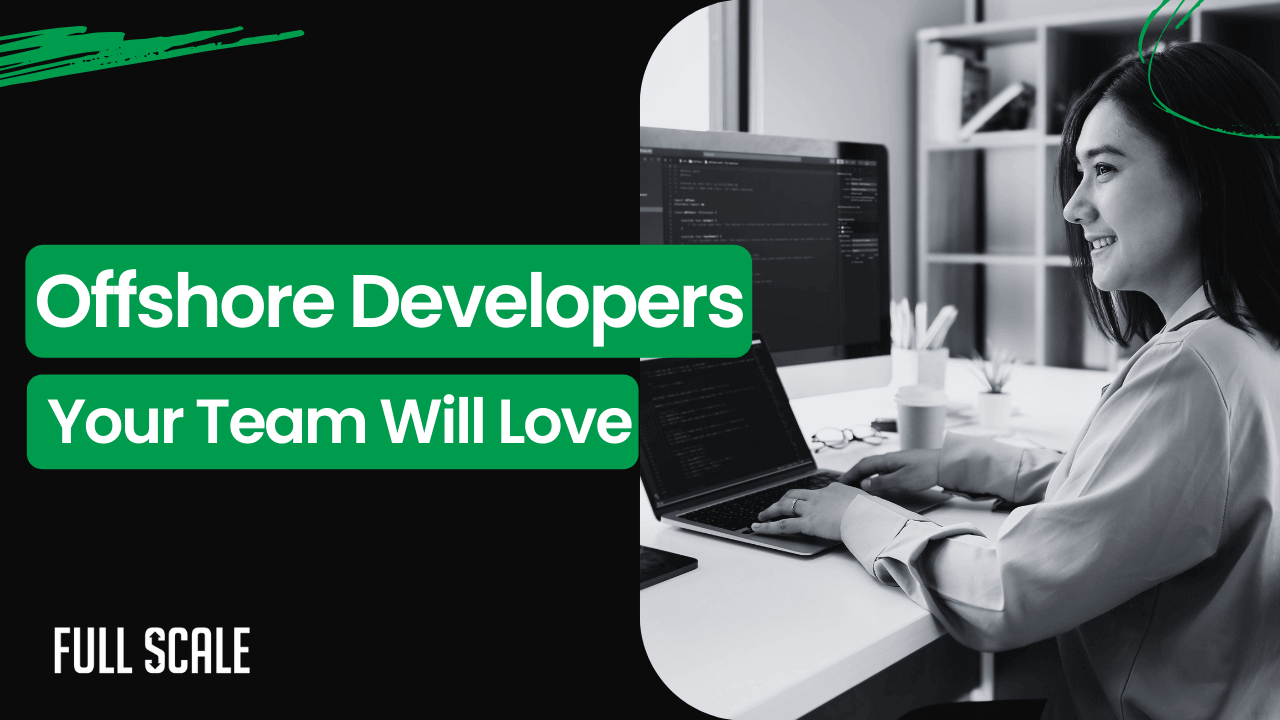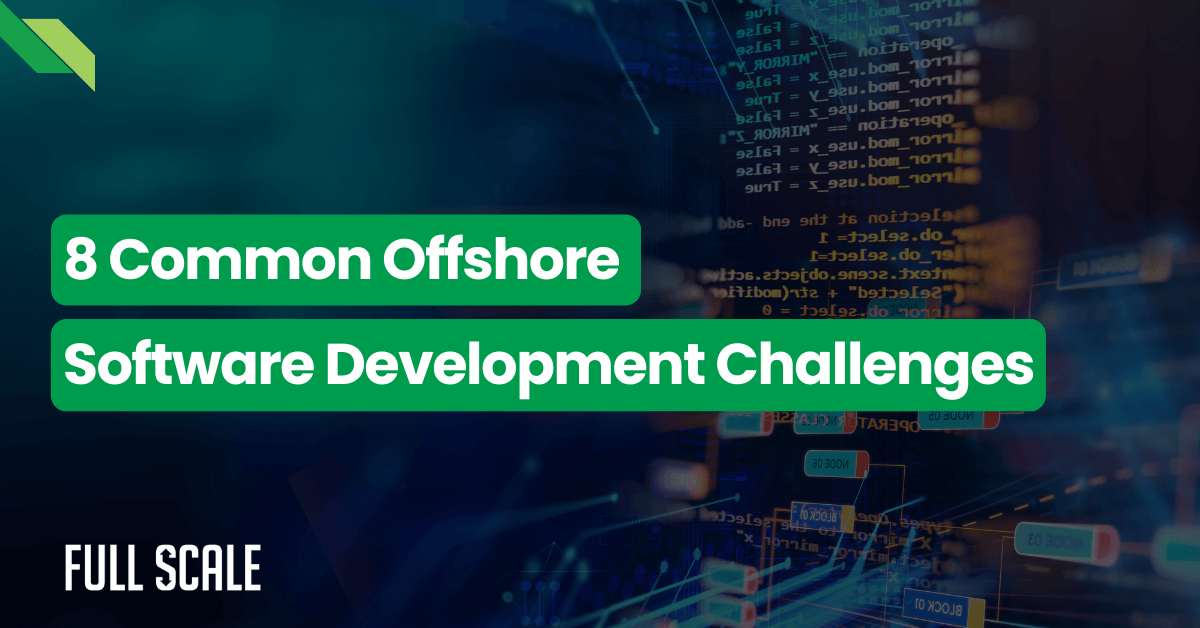Last Updated on 2025-06-16
Engineering conflict resolution has become critical for modern development teams. Research from GitLab’s 2024 Developer Survey shows that 67% of engineers report weekly technical disagreements. McKinsey’s 2024 Tech Talent Study reveals that teams lose 23% of productivity to unresolved conflicts.
Key challenges this framework addresses:
- Development delays from prolonged technical debates
- Team morale is impacted by unresolved disagreements
- Technical debt accumulation from rushed compromises
- Lost innovation opportunities from conflict avoidance
Traditional business mediation fails for engineering conflicts because technical complexity demands specialized approaches. The RESOLVE framework transforms engineering conflict resolution from a soft skill into a systematic process. Teams implementing structured approaches report 40% faster decision-making and improved satisfaction metrics.
This comprehensive guide explores how engineering leaders can build cultures where productive disagreements drive technical excellence. You’ll discover proven techniques for engineering conflict resolution that balance technical merit with team dynamics.
Why Technical Disagreements Arise in High-Performing Teams
High-performing engineering teams encounter disagreements precisely because they pursue excellence. Multiple valid solutions exist for complex technical challenges. Each approach carries distinct tradeoffs that reasonable engineers can disagree about. Understanding these root causes enables better engineering conflict resolution.
Technical Complexity Creates Multiple Valid Approaches
Modern software systems involve countless architectural decisions with no single correct answer. Database choices, API designs, and infrastructure patterns all present legitimate alternatives. Engineers naturally gravitate toward familiar solutions. The technical decision framework must acknowledge this multiplicity.
Common areas of technical disagreement:
- Microservices vs. monolithic architectures
- SQL vs. NoSQL database selections
- Synchronous vs. asynchronous communication patterns
- Container orchestration platform choices
Competing Priorities Drive Different Solutions
Engineering teams balance competing demands daily. Speed conflicts with scalability. Maintainability competes with performance. Cost constraints clash with ideal implementations.

These tensions create disagreements about priorities. Effective engineering conflict resolution requires explicit priority alignment.
Different Engineering Backgrounds Shape Perspectives
Engineers bring diverse experiences from previous projects. Startup developers value rapid iteration differently than enterprise engineers. These backgrounds shape fundamental assumptions about engineering practices. Cross-team collaboration requires bridging experiential gaps.
| Background Type | Primary Values | Common Assumptions | Conflict Points |
| Startup | Speed, flexibility | “Move fast and break things” | Over-engineering concerns |
| Enterprise | Stability, process | “Measure twice, cut once” | Velocity frustrations |
| Open Source | Community, standards | “Right way matters most” | Pragmatism debates |
| Agency | Deliverables, deadlines | “Ship and iterate” | Technical debt worries |
Sunk Cost and Emotional Investment
Engineers invest significant time researching solutions. This creates emotional attachment to specific approaches. Abandoning well-researched solutions feels wasteful. The sunk cost fallacy intensifies engineering conflict resolution challenges.
Signs of emotional investment:
- Defending solutions beyond technical merit
- Taking criticism personally
- Reluctance to consider alternatives
- Escalating discussions to win
Conway’s Law Influences Technical Decisions
System architectures mirror organizational structures. Teams design solutions that align with communication patterns. Disagreements often reflect organizational tensions. Effective architecture consensus addresses both technical and organizational factors.
The RESOLVE Framework: A Systematic Approach to Engineering Conflict Resolution
The RESOLVE framework provides structured engineering conflict resolution for technical disagreements. Each phase builds toward consensus. Teams report 60% faster resolution using this approach.
Framework Overview
The framework transforms chaotic debates into productive discussions. It separates emotions from technical analysis. Teams progress through defined stages. The structure prevents circular arguments.
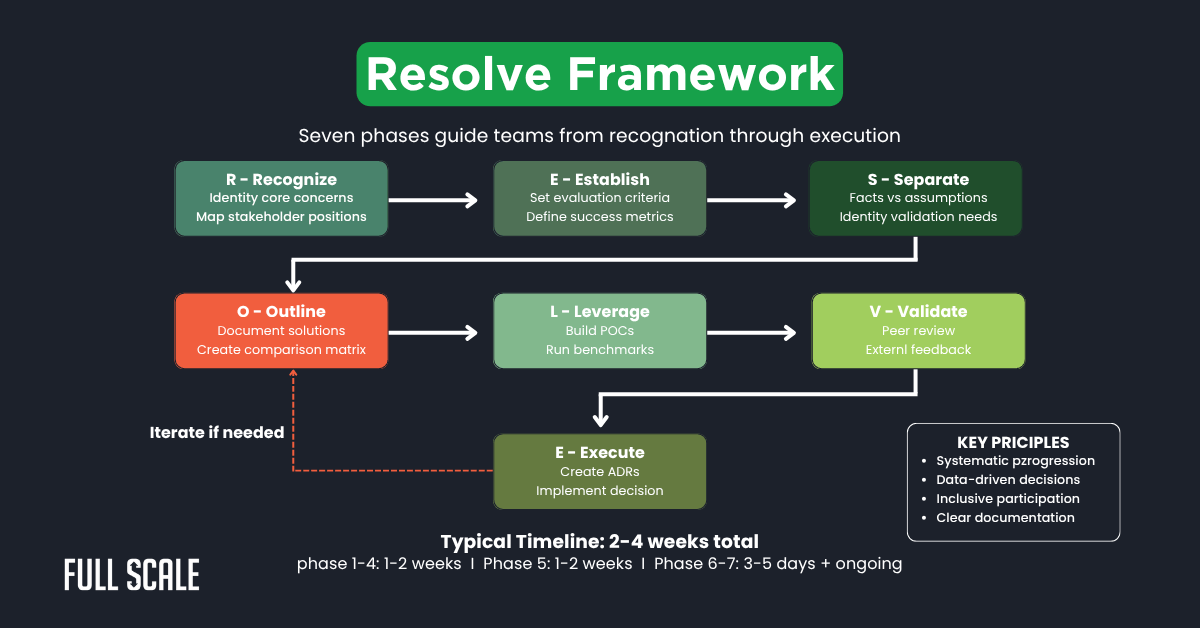
| Phase | Focus | Key Activities | Duration |
| Recognize | Identify concerns | Map positions, document constraints | 1-2 days |
| Establish | Set criteria | Define metrics, agree on factors | 1 day |
| Separate | Facts vs assumptions | List facts, identify assumptions | 2-3 days |
| Outline | Document options | Create matrix, detail approaches | 2-3 days |
| Leverage | Use data | Build POCs, run benchmarks | 1-2 weeks |
| Validate | Peer review | External review, feedback | 2-3 days |
| Execute | Implement | Create ADRs, communicate | Ongoing |
Recognize the Core Technical Concerns
Recognition maps stakeholder positions without judgment. Teams document technical concerns and reasoning. This surfaces hidden assumptions. A clear problem definition prevents solving the wrong challenges in engineering conflict resolution.
Recognition deliverables:
- Stakeholder concern matrix
- Technical constraint documentation
- Problem statement alignment
- Success criteria draft
Establish Shared Evaluation Criteria
Establishing criteria creates objective evaluation standards. Teams agree on measurable factors like performance benchmarks. This framework prevents moving goalposts. Evidence-based decisions require clear metrics for engineering conflict resolution.
Separate Facts from Assumptions
Separation distinguishes proven facts from untested assumptions. Teams list verifiable constraints versus beliefs. This identifies assumptions needing validation. Many engineering conflict resolution scenarios dissolve when assumptions face scrutiny.
| Category | Examples | Validation Method |
| Facts | The current system handles 1000 TPS | Performance logs |
| Facts | Database size is 2TB | Direct measurement |
| Assumptions | Users need sub-second response | User research |
| Assumptions | Traffic will grow 10x yearly | Business projections |
Outline Potential Solutions Objectively
Outlining document solutions without advocacy. Teams create neutral technical descriptions. Comparison matrices highlight differences. This objectivity enables the evaluation of rational technical tradeoffs.
Leverage Data and Prototypes
Data moves discussions from theory to evidence. Teams build minimal prototypes to test assumptions. Benchmarks provide comparison points. Data-driven engineering conflict resolution reduces emotional attachment.
Prototype guidelines:
- Time-box to 1-2 weeks
- Focus on the highest-risk assumptions
- Measure against the criteria
- Document limitations
Validate Through Peer Review
External perspectives prevent groupthink. Senior engineers review the analysis objectively. Fresh eyes spot overlooked concerns. Solution validation ensures thorough engineering conflict resolution.
Execute with Clear Documentation
Execution begins with comprehensive documentation. ADRs capture context and rationale. Clear communication ensures stakeholder understanding. Implementation proceeds with shared buy-in.
Phase 1: Setting the Stage for Productive Engineering Conflict Resolution
Creating the right environment precedes technical discussion. Teams establish psychological safety first. Clear ground rules prevent personal attacks. This foundation enables productive disagreements.
Creating Psychological Safety
Psychological safety allows voicing unpopular opinions. Leaders model vulnerability and uncertainty. Teams separate ideas from individuals. This encourages thorough engineering conflict resolution.
Safety indicators:
- Engineers challenge senior proposals
- “I don’t know” is acceptable
- Failed experiments are a learning
- Disagreement doesn’t affect reviews
Establishing Decision Authority
Clear authority prevents endless debates. Teams identify final decision makers. Escalation paths provide recourse. This clarity accelerates engineering conflict resolution.
| Decision Type | Authority | Escalation | Timeline |
| Implementation | Team lead | Tech lead → Principal | 1-2 days |
| API design | Tech lead | Principal → Board | 3-5 days |
| Tech stack | Principal | Board → CTO | 1-2 weeks |
| Platform | Board | CTO → Executive | 2-4 weeks |
Documenting Parameters and Timelines
Documentation creates shared understanding. Teams record negotiable aspects versus constraints. Clear timelines prevent analysis paralysis. This channel’s engineering conflict resolution is productive.
Essential parameters:
- Budget constraints
- Regulatory requirements
- Technology commitments
- Timeline pressures
- Team capacity
Strategic Stakeholder Involvement
Strategic involvement prevents late surprises. Teams map input versus update needs. Early decision-maker involvement prevents waste. Stakeholder alignment enables smooth engineering conflict resolution.
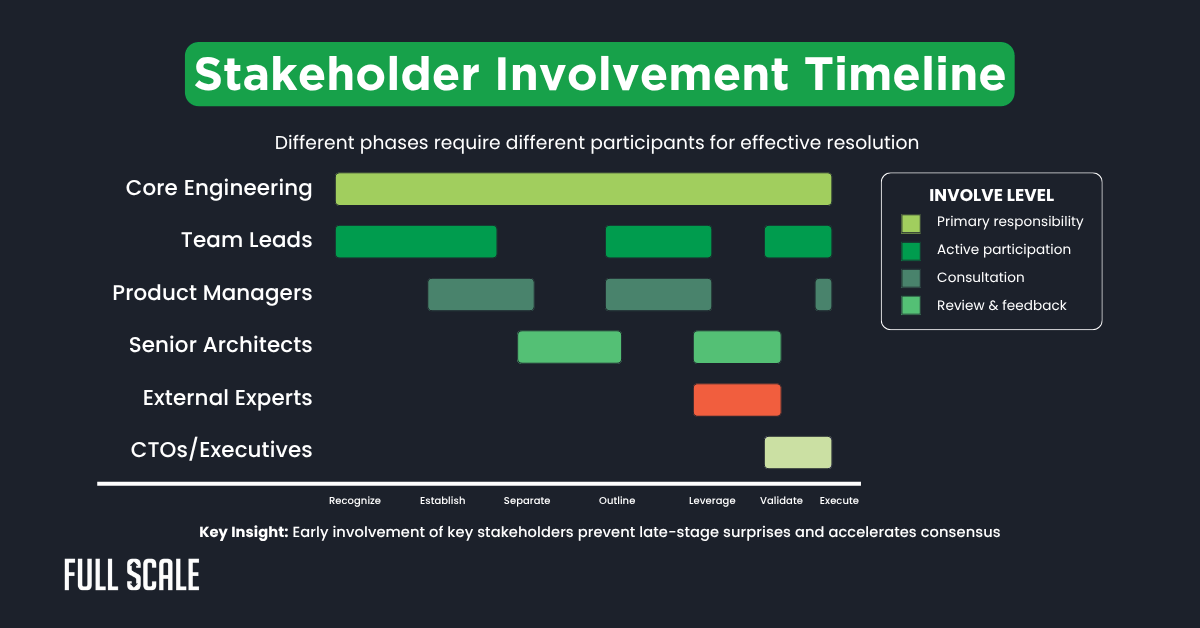
Phase 2: Structured Problem Exploration
Problem exploration transforms vague disagreements into specific questions. Teams dissect complex issues systematically. This reveals root causes. Structured exploration prevents premature solutions in engineering conflict resolution.
Uncovering Hidden Assumptions
Hidden assumptions derail discussions. Teams use “Five Whys” analysis. Assumption mapping makes beliefs explicit. This reveals misalignments in engineering conflict resolution.
Five Whys Example:
- Why microservices? → Better scalability
- Why scalability? → System slows under load
- Why slow? → Database bottleneck
- Why bottleneck? → All services hit the same tables
- Why the same tables? → Poor data model
Breaking Down Complex Disagreements
Complex disagreements become testable components. Teams identify specific claims. Each becomes a validation hypothesis. This scientific approach improves engineering conflict resolution.
| Disagreement | Components | Validation |
| “Microservices better” | Deployment improves | Measure frequency |
| Latency acceptable | Benchmark calls | |
| Complexity manageable | Track maintenance | |
| Productivity increases | Monitor velocity |
Steel Man Arguments
Steel Manning strengthens opposing viewpoints. Engineers articulate best alternative arguments. This ensures addressing real concerns. Respectful engagement builds trust in engineering conflict resolution.
Visualizing Tradeoffs
Decision matrices make tradeoffs concrete. Teams score solutions against criteria. Visual representation clarifies strengths. This objectivity navigates technical tradeoffs during engineering conflict resolution.

Phase 3: Evidence-Based Convergence
Evidence replaces opinions with data. Teams validate competing claims empirically. Prototypes provide objective comparisons. This builds consensus through facts in engineering conflict resolution.
POCs vs. Theoretical Analysis
Choosing validation approaches depends on uncertainty. High-risk assumptions need hands-on validation. Well-understood domains use theoretical comparison. Teams balance thoroughness with time in engineering conflict resolution.
Decision criteria:
1. Build POC when:
- Technology unfamiliar
- Performance critical
- Integration complex
- Vendor claims unclear
2. Analyze when:
- Pattern documented
- Models exist
- Time constrained
- Changes reversible
Structuring A/B Tests
A/B testing brings scientific rigor. Teams implement minimal competing versions. Controlled experiments measure differences. This settles engineering conflict resolution debates definitively.
| Element | Best Practice | Common Pitfall |
| Sample size | Statistical significance | Too small |
| Duration | Multiple cycles | Single snapshot |
| Implementation | Equal optimization | Bias favorite |
| Metrics | Automated collection | Manual selective |
External Expertise
Industry experts provide valuable perspective. Vendor engineers clarify capabilities. Outside input breaks deadlocks. Strategic expertise accelerates engineering conflict resolution.
Time-boxing Experiments
Time constraints force progress. Experiments run within defined periods. This prevents analysis paralysis. Teams commit based on available evidence in engineering conflict resolution.
Phase 4: Documentation and Knowledge Sharing
Documentation transforms decisions into organizational knowledge. Teams capture outcomes and reasoning. This prevents re-litigation. Effective documentation accelerates future engineering conflict resolution.
Architectural Decision Records
ADRs structure significant decisions. Teams record context and rationale. This format ensures completeness. Well-written ADRs support engineering conflict resolution.
ADR sections:
- Title: Decision description
- Status: Proposed/Accepted/Deprecated
- Context: Problem and constraints
- Decision: Chosen approach
- Consequences: Impacts
- Alternatives: Other options
Documenting Rationale
Rationale documentation captures thinking processes. Teams record key insights. This context helps future understanding. A comprehensive rationale prevents second-guessing in engineering conflict resolution.
Building Decision Repositories
Repositories create searchable memory. Teams tag by technology and impact. Search helps find precedents. This knowledge base accelerates engineering conflict resolution.
| Feature | Purpose | Implementation |
| Tagging | Categorization | Tech, domain, impact |
| Search | Discovery | Full-text and metadata |
| Version control | History | Git-based |
| Review | Quality | Quarterly checks |
| Access | Security | Role-based |
Stakeholder Communication
Communication translates decisions appropriately. Engineers craft audience-specific messages. Executives see business impacts. Technical teams get implementation details for engineering conflict resolution.
Real-World Case Study: FinTech Corp
FinTech Corp faced critical scaling challenges. Their monolith struggled under transaction loads. Engineers are split between microservices and optimization. This stalled development for months.
The Stalled Debate
The debate consumed resources without progress. Microservice advocates cited scalability benefits. Monolith defenders emphasized operational concerns. Neither acknowledged valid opposing points.
Impact metrics:
- Feature delivery: Down 65%
- Team morale: Dropped 40%
- Architecture meetings: 15 hours/week
- Blocked stories: 47% of backlog
Framework Reveals Hidden Concerns
The RESOLVE framework uncovered deeper issues. Recognition revealed team structure concerns. Engineers feared losing autonomy. Others worried about on-call burden. Engineering conflict resolution exposed root causes.
Consensus Solution Emerges
Evidence produced unexpected insights. Performance testing validated the monolith optimization potential. Microservice prototypes revealed complexity. Data challenged both sides’ assumptions.
| Metric | Monolith | Microservices | Hybrid |
| Latency | 120ms | 340ms | 150ms |
| Deploy time | 45 min | 15 min/service | 25 min |
| Operations | Baseline | 3.5x | 1.5x |
| Velocity | 1.2x | 0.8x | 1.4x |
Measurable Outcomes
Post-implementation validated the approach. Deployment increased 40%. Performance improved 3x. Team satisfaction reached 85%. Engineering conflict resolution delivered results.
Adapting for Different Contexts
Organizations adapt the framework uniquely. Startups differ from enterprises. Remote teams face distinct challenges. Principles remain constant while implementation varies for engineering conflict resolution.
Startup vs. Enterprise
Startups need compressed timelines. Documentation stays lightweight. Speed matters most. Enterprises demand formal procedures. Governance adds complexity. Engineering conflict resolution adapts accordingly.
| Aspect | Startup | Enterprise |
| Timeline | 1-2 weeks | 4-6 weeks |
| Documentation | Lightweight | Comprehensive |
| Stakeholders | 3-5 people | 10-20 people |
| Approval | Single maker | Multiple boards |
| Risk tolerance | Higher | Lower |
Remote Team Considerations
Remote teams require intentional strategies. Asynchronous collaboration replaces spontaneous discussion. Time zones affect scheduling. Digital tools support distributed engineering conflict resolution.
Cross-functional Disagreements
Product-engineering conflicts need special handling. Technical excellence balances business objectives. Both perspectives need representation. Engineering conflict resolution bridges different viewpoints.
External Partner Disagreements
External disagreements add complexity. Organizational boundaries require respect. Information sharing needs consideration. Professional relationships survive through structured engineering conflict resolution.
Measuring Success Beyond Decisions
Success extends beyond decision velocity. Quality matters over time. Team health equals technical outcomes. Comprehensive measurement improves engineering conflict resolution.
Team Satisfaction Metrics
Surveys gauge process satisfaction. Psychological safety tracks progress. Anonymous feedback reveals concerns. Soft metrics predict performance in engineering conflict resolution.
Decision Quality Assessment
Reviews evaluate effectiveness over time. Teams compare outcomes with predictions. Unexpected consequences get documented. Retrospective analysis improves future engineering conflict resolution.
| Timeline | Focus | Questions |
| 1 month | Progress | Following decision? |
| 3 months | Indicators | Metrics match? |
| 6 months | Assessment | Right choice? |
| 1 year | Impact | Do differently? |
Implementation Tracking
Tracking ensures decisions become action. Teams monitor adoption rates. Deviations get investigated. Follow-through validates engineering conflict resolution.
Continuous Feedback Loops
Feedback drives framework evolution. Teams conduct regular retrospectives. Process improvements get shared. The framework becomes living through engineering conflict resolution.
Building a Culture of Productive Disagreement
Organizations must embrace productive engagement. Disagreements signal caring engineers. The RESOLVE framework channels energy constructively. Cultural transformation requires sustained engineering, conflict resolution, and commitment.
From Avoidance to Engagement
Healthy cultures embrace disagreement as a fuel. Teams separate technical from personal. Disagreement discovers optimal solutions. This transforms dynamics through engineering conflict resolution.
Transformation indicators:
- Increased discussions
- Reduced tensions
- Faster cycles
- Higher innovation
- Improved retention
CTO Leadership Role
CTOs model effective culture. They demonstrate vulnerability and openness. Their participation legitimizes the process. Executive support ensures engineering conflict resolution adoption.
Long-term Benefits
Structured approaches improve satisfaction. Engineers feel valued and heard. Technical excellence improves systematically. Benefits compound through consistent engineering conflict resolution.
Measured benefits:
- Retention: 25% improvement
- Code quality: 40% better
- Reliability: 3x improvement
- Team NPS: +45 points
- Recruitment: 2x faster
Implementation Next Steps
Implementation begins with pilot projects. Teams receive framework training. Early successes build momentum. Gradual rollout ensures sustainable engineering conflict resolution.
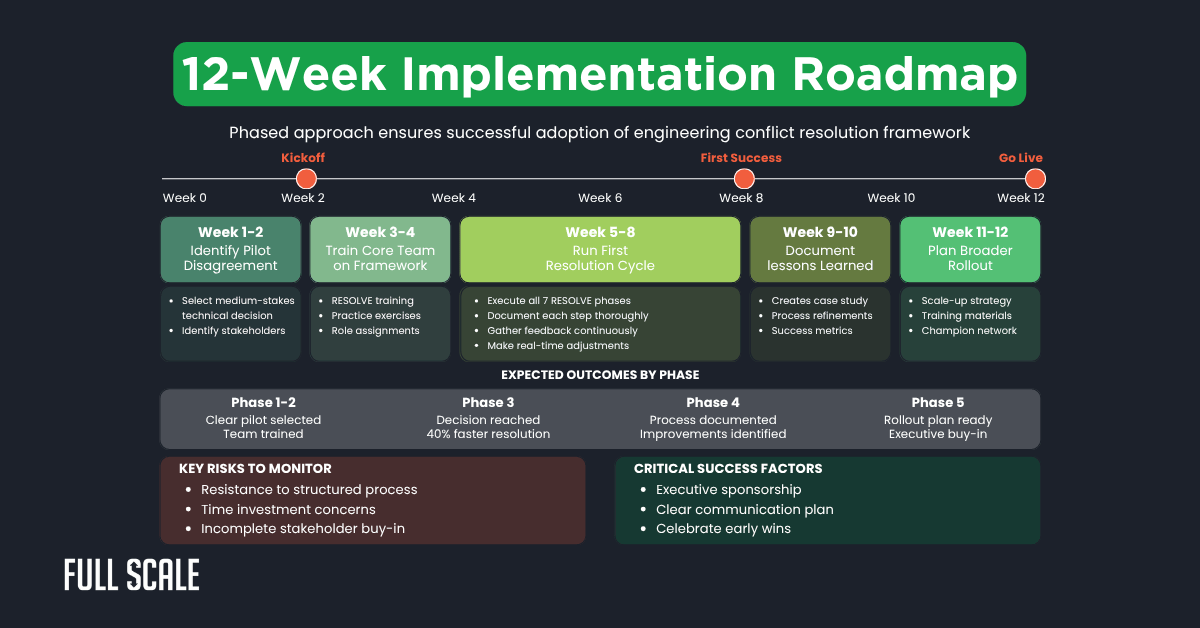
Roadmap phases:
- Week 1-2: Identify pilot
- Week 3-4: Train team
- Week 5-8: Run cycle
- Week 9-10: Document lessons
- Week 11-12: Plan rollout
Build High-Performance Engineering Teams with Full Scale
Technical disagreements shouldn’t derail development momentum. Teams need expertise and processes for effective engineering conflict resolution. Full Scale helps build teams with technical excellence and collaborative skills.
Why Full Scale for Engineering Excellence?
- Senior Talent: Developers experienced in resolving technical conflicts
- Proven Frameworks: Teams integrate smoothly with structured engineering conflict resolution expertise
- Technical Leadership: Principal engineers facilitate objective evaluations
- Scalable Structure: Engineers skilled in consensus and delivery
Transform disagreements into innovation opportunities. Discover how Full Scale strengthens engineering culture while accelerating development.
Start Building Your Team
FAQs: Engineering Conflict Resolution
How long does engineering conflict resolution typically take using the RESOLVE framework?
The RESOLVE framework for engineering conflict resolution typically completes within 2-4 weeks:
- Phases 1-4 (Recognition through Outlining): 1-2 weeks
- Phase 5 (Leverage/Testing): 1-2 weeks
- Phases 6-7 (Validation and Execution): 3-5 days plus ongoing implementation
Simpler disagreements may resolve faster, while complex architectural decisions involving scaling engineering culture changes might extend to 6 weeks.
What’s the minimum team size needed for effective engineering conflict resolution?
Effective engineering conflict resolution works with teams as small as 3-5 engineers:
- Core team: 2-3 engineers with opposing viewpoints
- Facilitator: 1 neutral party (team lead or architect)
- Reviewer: 1 external perspective for validation
Larger teams benefit from structured engineering communication protocols to ensure all voices are heard without creating decision paralysis.
How do you handle engineering conflict resolution when team members refuse to compromise?
When facing rigid positions in engineering conflict resolution:
- Return to shared goals and success metrics
- Use data from prototypes to shift focus from opinions to evidence
- Involve senior engineering leadership to provide perspective
- Consider time-boxed experiments where both approaches run in parallel
- Document concerns for future retrospective analysis
The framework’s structure often reveals that perceived conflicts stem from different priorities rather than fundamental disagreements.
Can engineering conflict resolution work effectively in fully remote teams?
Remote engineering conflict resolution requires adapted tools but remains highly effective:
- Use collaborative whiteboards for visual technical decision framework mapping
- Record key sessions for team members in different time zones
- Implement asynchronous decision documentation
- Schedule focused video sessions for critical discussions
- Leverage written communication for clearer decision documentation
Many remote teams report better outcomes due to enforced documentation and structured communication.
What role does technical debt management play in engineering conflict resolution?
Technical debt management frequently triggers engineering conflict resolution needs:
- Short-term fixes vs. long-term refactoring debates
- Resource allocation between new features and debt reduction
- Defining acceptable debt levels for different system components
- Prioritizing which debt to address first
The RESOLVE framework helps teams quantify debt impact and make evidence-based tradeoff decisions.
How can Full Scale help teams implement engineering conflict resolution frameworks?
Full Scale accelerates engineering conflict resolution implementation through:
- Experienced facilitators: Senior engineers trained in mediating technical disagreements
- Framework expertise: Teams already practicing structured engineering communication and decision-making
- Scalable support: Additional engineers to prototype competing solutions during evaluation phases
- Documentation culture: Built-in practices for thorough decision documentation and knowledge sharing
Our teams integrate seamlessly with your existing processes while bringing proven conflict resolution methodologies that enhance scaling engineering culture.

Matt Watson is a serial tech entrepreneur who has started four companies and had a nine-figure exit. He was the founder and CTO of VinSolutions, the #1 CRM software used in today’s automotive industry. He has over twenty years of experience working as a tech CTO and building cutting-edge SaaS solutions.
As the CEO of Full Scale, he has helped over 100 tech companies build their software services and development teams. Full Scale specializes in helping tech companies grow by augmenting their in-house teams with software development talent from the Philippines.
Matt hosts Startup Hustle, a top podcast about entrepreneurship with over 6 million downloads. He has a wealth of knowledge about startups and business from his personal experience and from interviewing hundreds of other entrepreneurs.


